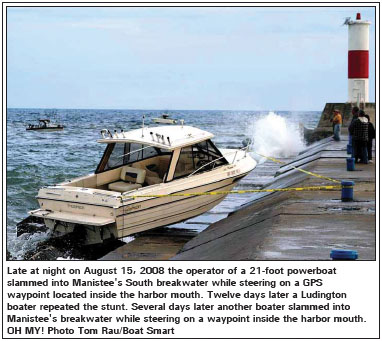|
Don’t let the GPS lead you astray
by Tom Rau

Over the years I have been tempted to call my column "Boat Stupid", and the temptation to title my book "Boat Stupid Chronicles" rather than "Boat Smart" was even more tempting.
I don't mean to be mean, bitter or sarcastic regarding the "Boat Stupid" dig but rather one at wits end regarding an endless continuum of less than safe boating behavior that crosses my Boat Smart desk. Let me make it perfectly clear that it is not boaters but their boating behavior that fuels my frustrations.
Let me share several cases of less than smart boating behavior that recently crossed my desk. Both cases involve boaters who recently slammed into Lake Michigan breakwaters at night while steering on a GPS waypoint. Let me put these breakwater collisions in perspective so you may understand the degree of my frustrations.
What sensible person would drive down a country dirt road at night at a high rate of speed without headlights, or drive at night through a busy mall parking lot at 60 miles per hour, or approach an unfamiliar harbor at night at a high rate of speed locked on a GPS waypoint programmed inside a harbor enclosed by breakwaters.
Thank goodness such reckless high-speed behavior, to the best of my knowledge, seldom visits mall parking lots or county dirt roads. As for boaters visiting harbors at night at a high rate of speed and crashing into structures, the numbers are overwhelming.
Two recent breakwater collisions brings my count to 68. These collisions, which left boaters high and dry, left some seriously injured, and left others in the hereafter, mostly occurred between Chicago and Frankfort, Michigan, over the last 12 years. I suspect more have occurred, but the impact did not cripple the boat, so the mishap went unreported. I seriously doubt boaters would report a breakwater encounter if they could slip away veiled in the darkness of night.
Two most recent breakwater collisions offer hard-earned lessons. The first collision occurred on August 15, 2008, at Manistee harbor. At approximately 10:22 p.m., a 21- foot powerboat with five people aboard slammed into Manistee's South breakwater. Miraculously no one was injured. Alcohol was not involved.
The boat operator told marine salvager Richard Lenardson of TowBoatU.S. that he was steering on a GPS waypoint that he had earlier programmed inside the harbor mouth. He also told Lenardson that he had difficulty reading the aids to navigation lights at the harbor.
"When he struck the upward sloped riprap rocks at the base of the breakwater, it propelled the boat skyward and down onto the breakwater," said Lenardson.
Imagine one moment you're racing towards the harbor, the next you're skyward bound staring at stars, a microsecond later you're downward bound as boat and concrete clash with an explosive impact that draws 911 calls.
Twelve days later a 19-foot powerboat with three people aboard slammed into Ludington's south breakwater at around 11 p.m., in a clone-like repeat of the Manistee foray. There were no injuries and alcohol was not involved. As with the Manistee collision the operator reportedly was steering on a GPS waypoint located at the Loomis Street boat ramps located inside the harbor breakwater. He also reported being confused by the harbor aids to navigation lights.
Why didn't the operators, when confused about the lighted aids to navigation throttle back and assess the situation? What's more, both operators were out-of-towners and reportedly not familiar with the harbor. Even more reason to bring back the throttles.
I can understand programming a GPS waypoint inside a harbor breakwater system, but I strongly discourage it. Most knowledgeable boaters program a waypoint safely off the harbor entrance and then approach the harbor at slow bells.
Another approach prudent boaters exercise is consulting a navigation chart, especially if approaching an unfamiliar harbor at night.
Countless boaters have safely approached Manistee and Ludington at night as have countless other boaters around Lake Michigan and across the Great Lakes. This suggests that most boaters do bring back the throttles when approaching harbors at night.
Boat Smart-follow their lead and don't let the GPS lead you astray.
The following crossed my desk just before deadline: On August 25, 2008, a 18- foot powerboat slammed into Lake a Michigan breakwater at Kenosha, Wisconsin early Monday morning. The 31-year-old operator was killed. A 26-year-old female suffered a spinal fracture and other back injuries after being ejected from the boat. Authorities believe alcohol was involved. The accident remains under investigation. Several days later another boat slammed into Manistee's South Breakwater. No one was injured and alcohol was not involved. According to investigating authorities the boater was steering on a GPS waypoint inside the harbor mouth.
Tom Rau is a retired 27-year Coast Guard veteran, boating safety columnist, and author of Boat Smart Chronicles, Lake Michigan Devours Its Wounded, a 20-year journal of recreational boating mishaps with valuable lessons learned.
www.boatsmart.net
TOP
|